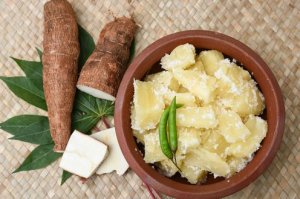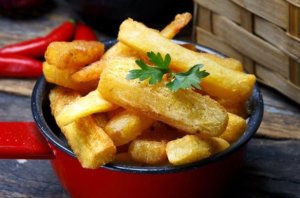Cassava Nutrition Facts

With so many food choices in our diets, it’s important not to forget to include starchy vegetables. Including tubers, such as cassava, will bring more choices to a balanced diet. In our culture, this tuber is a little-known food, but it contains many benefits.
Why introduce products from other cultures into our diet?
When we think of a healthy diet, lettuce and chicken breast always come to mind! However, although you may enjoy a healthy diet, sometimes we can consistently fill our plates with monotony and neutral flavors.
Trying different ways of cooking the same foods are only the beginning. The culinary adventure should continue with new foods. It’s important to learn how to cook them and understand what they contribute to our diet. Just because a food is popular in another culture, doesn’t necessarily mean that it’s healthy. However, in small quantities, and on occasions, it can be interesting to try foods from other cultures.
Cassava: a whole new discovery

Cassava, also known as manioc, is a tuber that’s native to the tropical areas of the Americas. The environmental conditions necessary for its growth are mainly heat and humidity. However, these woody shrubs can also adapt to other climates. Its cultivation is of low economic impact, and it can grow even in dry conditions.
The part of the cassava that we consider to be food are the roots, similar to the carrot or the potato. It’s consumed in the same way as these popular vegetables, but the nutritional composition of cassava is pleasantly different.
Nutritional composition of cassava
Cassava, unlike other tubers with which we could compare, contains 90 percent starch, and it’s very low in proteins and fats. This nutritional information is according to a study published in the Nigerian Journal of Science. On the other hand, although its concentration of vitamin C, calcium and some B complex vitamins is interesting, levels of micronutrients are scarce.
However, it’s worth noting that the leaves that emerge from the tuber have a higher ratio of proteins, similar or even greater than soybeans. Although, the leaves are usually discarded from the vegetable, they have small amounts of fiber. They are also a source of polyphenols and tannins (found in grapes) that stand out for their antioxidant action.
According to the research carried out in Nigeria, cassava also contains cyanogenic carbohydrates. Therefore, if consumption is extreme, and in the framework of a diet deficient in vitamins and minerals, it can cause illnesses ranging from neuropathy to poisoning.
Don’t panic! In order for this to happen, we would have to practically have a solely cassava-based diet, and nothing else. And as we have already said, what we want to achieve is variety and new flavors within our current diets.

Properties of cassava
As we have already said, cassava consists mainly of carbohydrates, which is why it’s a high-energy food. Moreover, a large part of the starch is resistant, which provides dietary fiber.
The resistant starch benefits the intestinal transit, produces satiety, improves metabolic conditions and provides an aid to weight loss. Cassava isn’t a food that contains a high nutritional density. Therefore, if we want to consume it, it should be within a balanced diet that guarantees vitamins and minerals. A balanced diet should always contain quality proteins, particularly the ones that are not found in this tuber.
Another useful property of cassava is that from this product we can obtain a flour, similar to that produced by tapioca, and without gluten. So it’s a product that can diversify the diet of celiac patients.
How can we consume it?
It’s a tuber much more dense in starch than potato, which also makes it tastier. It has a white to yellow color, a neutral flavor, although it may be sweeter if we choose a variety that’s richer in fructose.
Be careful if you experience a bitter taste because this could indicate a high cyanide content. This tuber is cooked in less than 30 minutes, and can be eaten boiled, steamed, grilled or baked or fried, just like potatoes.
With so many food choices in our diets, it’s important not to forget to include starchy vegetables. Including tubers, such as cassava, will bring more choices to a balanced diet. In our culture, this tuber is a little-known food, but it contains many benefits.
Why introduce products from other cultures into our diet?
When we think of a healthy diet, lettuce and chicken breast always come to mind! However, although you may enjoy a healthy diet, sometimes we can consistently fill our plates with monotony and neutral flavors.
Trying different ways of cooking the same foods are only the beginning. The culinary adventure should continue with new foods. It’s important to learn how to cook them and understand what they contribute to our diet. Just because a food is popular in another culture, doesn’t necessarily mean that it’s healthy. However, in small quantities, and on occasions, it can be interesting to try foods from other cultures.
Cassava: a whole new discovery

Cassava, also known as manioc, is a tuber that’s native to the tropical areas of the Americas. The environmental conditions necessary for its growth are mainly heat and humidity. However, these woody shrubs can also adapt to other climates. Its cultivation is of low economic impact, and it can grow even in dry conditions.
The part of the cassava that we consider to be food are the roots, similar to the carrot or the potato. It’s consumed in the same way as these popular vegetables, but the nutritional composition of cassava is pleasantly different.
Nutritional composition of cassava
Cassava, unlike other tubers with which we could compare, contains 90 percent starch, and it’s very low in proteins and fats. This nutritional information is according to a study published in the Nigerian Journal of Science. On the other hand, although its concentration of vitamin C, calcium and some B complex vitamins is interesting, levels of micronutrients are scarce.
However, it’s worth noting that the leaves that emerge from the tuber have a higher ratio of proteins, similar or even greater than soybeans. Although, the leaves are usually discarded from the vegetable, they have small amounts of fiber. They are also a source of polyphenols and tannins (found in grapes) that stand out for their antioxidant action.
According to the research carried out in Nigeria, cassava also contains cyanogenic carbohydrates. Therefore, if consumption is extreme, and in the framework of a diet deficient in vitamins and minerals, it can cause illnesses ranging from neuropathy to poisoning.
Don’t panic! In order for this to happen, we would have to practically have a solely cassava-based diet, and nothing else. And as we have already said, what we want to achieve is variety and new flavors within our current diets.

Properties of cassava
As we have already said, cassava consists mainly of carbohydrates, which is why it’s a high-energy food. Moreover, a large part of the starch is resistant, which provides dietary fiber.
The resistant starch benefits the intestinal transit, produces satiety, improves metabolic conditions and provides an aid to weight loss. Cassava isn’t a food that contains a high nutritional density. Therefore, if we want to consume it, it should be within a balanced diet that guarantees vitamins and minerals. A balanced diet should always contain quality proteins, particularly the ones that are not found in this tuber.
Another useful property of cassava is that from this product we can obtain a flour, similar to that produced by tapioca, and without gluten. So it’s a product that can diversify the diet of celiac patients.
How can we consume it?
It’s a tuber much more dense in starch than potato, which also makes it tastier. It has a white to yellow color, a neutral flavor, although it may be sweeter if we choose a variety that’s richer in fructose.
Be careful if you experience a bitter taste because this could indicate a high cyanide content. This tuber is cooked in less than 30 minutes, and can be eaten boiled, steamed, grilled or baked or fried, just like potatoes.
This text is provided for informational purposes only and does not replace consultation with a professional. If in doubt, consult your specialist.








